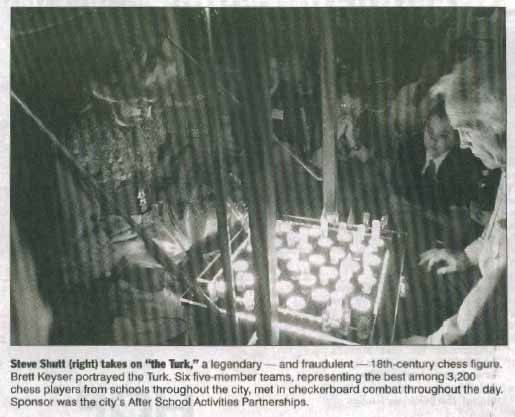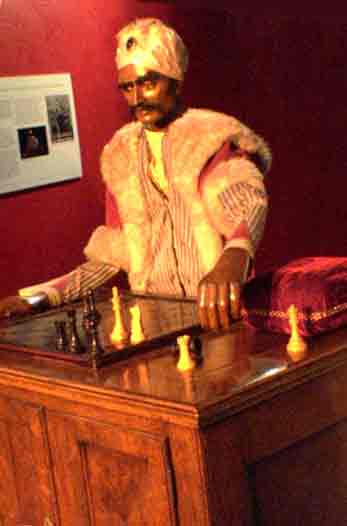|
I'm a Turk-aholic.
I have a thing for
von Kempelen's famous Automaton.
I'm not about to
put its entire history here. That would take a short book. But I thought I'd
offer some embellishments - things most people don't see, or even look for
concerning the Turk.
My friend sent me
this neat newspaper clipping -
For those who know
little or nothing about the Turk, here's a
good overview.
A short story about
a Turk-like Automaton written by Ambrose Gwinnett Bierce 1910 called
Moxon's Master
In 1832 Hannah
Flagg Gould (1789-1865) of Boston, Massachusetts wrote and had published a poem
called, "Address
to the Automaton Chess Player" and it's the first published
chess-related work by a woman in America.
 Tom
Standage wrote The Turk: the Life and Times of the Famous
eighteenth-Century Chess-Playing Machine Tom
Standage wrote The Turk: the Life and Times of the Famous
eighteenth-Century Chess-Playing Machine
This book deals
very little with the chess aspect but delves into the ideas of automata and A.
I. It's very well researched and equally well written.
Books on the Turk:
The Turk: The
Life and Times of the Famous Eighteenth-Century Chess-Playing Machine by
Tom Standage 2002.
The Turk,
Chess Automaton by Gerald M. Levitt 2000.
The Great
Chess Automaton by Charles Michael Carroll (116 pages) Dover
Publications 1975.
Modus
operandi, or, The automaton chess-player: A play in three acts, with prefatory
remarks, and extracts from original letters on De Kempelin's automaton
chess-player, published in 1784 by J. Walker - T.H. Lacy,1866
The Automaton
Chess-Player by E. S. D. - Littell, Son & Co 01, 1859.
Edgar Allan
Poe and Baron von Kempelen's Chess-Playing Automaton by Henry
Ridgely Evans.
Edgar Allan Poe,
"Maelzel's
Chess-Player," Southern Literary Journal, April 1836
Automate
Joueur d’Echecs by anonymous, 1834.
Observations
upon the automaton chess player of von Kempelen, and upon other automata and
androides, now exhibiting in the United States, by Mr. Maelzel: ... upon the
chess-board, by the knight's move by Thomas P Jones.
The history
and analysis of the supposed automaton chess player of M. de Kempelen,: Now
exhibiting in this country by Mr. Maelzel; with lithographic figures, ...
method by which its motions are directed by Gamaliel Bradford -
Hilliard, Gray, 1826.
Chess: A
selection of fifty games, from those played by the automaton chess-player,
during its exhibition in London in 1820. Taken down, by permission of Mr.
Maelzel, at the time they were played by W. J. Hunneman.
An attempt to
analyse the automaton chess player, of Mr. de Kempelen ... to which is added,
a ... collection of the knight's moves over the chess board
by Robert Willis 1819.

John Gaughan devoted 20 years and $120,000 re-creating the Turk. His re-creation
uses the actual chess board that was part of the original Turk
(The chess board wasn't stored with the Turk in the Chinese Museum that burned
to the ground in 1854, but rather was kept in its owner's, Dr. Mitchell's,
office.)
Gaughan owns a
business that creates and supplies magicians with props and
tools-of-their-trade. His "Turk," a near perfect reproduction, gave it's
first performance in November 1989.
The New Turk
Anne Sunnuck's
Encyclopedia of Chess gives this article on the Turk:
TURK, THE
Anne Sunnuck
'The Turk' was an automaton chess player, constructed in Vienna in
1769 by Baron Wolfgang von Kempelen, an Hungarian engineer.
The automaton was a life-sized figure, dressed as a Turk, seated
behind a chest approx. 4 feet long, 2 feet wide and 3 feet high, the
top of which was a chessboard. 'The Turk' took on all corners at
chess, moving the pieces with his left hand.
Before each exhibition, the inside of the chest was shown to the
audience, and appeared to contain a lot of intricate machinery, which
was heard in motion while the game was being played. There was much
conjecture on how the automaton worked, as the figure had no legs and
the machinery appeared to occupy the whole of the inside of the chest.
It was first exhibited in Vienna in 1770 and later visited Dresden,
Leipzig, Paris and London, where it was installed at 8 Saville Row,
Burlington Gardens, in 1784. Visitors paid an admission fee of 5
shillings.
After Kempelen's death in 1804 'The Turk' was bought by Johann
Maelzel, a Bavarian musician, who exhibited it in Germany, Paris,
London and Amsterdam before it went to the United States in 1826.
Napoleon played against it when it was in Schönbrunn in 1809.
When Maelzel died in 1837 'The Turk' changed hands several times and
finally ended up in the Chinese Museum in Philadelphia, where it was
destroyed by fire in 1854.
There are a lot of varying accounts of the history of 'The Turk'. One
story of its origin is that during the revolt at Riga in 1769 a rebel
officer named Warousky had his legs shattered by a cannon ball and
they had to be amputated. The doctor who hid him was a friend of
Kempelen's. One day when Kempelen was watching Warousky, a strong player,
playing chess with the doctor, he struck upon the idea of a
chess automaton as a means of making money and at the same time
employing Warousky.
There are several versions of how the automaton was operated. One was that
the player hidden inside the automaton was able to enter it,
after inspection, and by squeezing his head through the large neck of
the figure could see the board through the mask. Another is given by
H. J. R. Murray in his History of Chess:The device was really quite simple:
a strong magnet was fixed within the base of each chessman and from the
inner surface of the chest, immediately below the board, were suspended
small iron balls by threads. As long as the chessman stood on a particular
square, the corresponding ball was attracted against the roof of the
chest, and soon as it was lifted from its place, the ball fell to the length
the thread.
A number of
different players, all of small stature and of master or near master
strength were engaged to operate the automaton. They included Allgaier,
Lewis, Boneourt and Mouret.
Actually, Boncourt
and later Schlumburger were both well over 6 feet tall. [sbc]
|
Archives by Title
links
personal
Sarah's Serendipitous Chess Page
The Life and Chess of Paul Morphy
chess - general
Chesslinks Worldwide
chess - history
Mark Week's History on the Web
Chess Journalists of America
Chess History Newsgroup
Hebrew Chess
Chess Tourn. & Match History
Super Tournaments of the Past
La grande storia degli scacchi
Bobby Fischer
Bill Wall's Chess Pages
|

